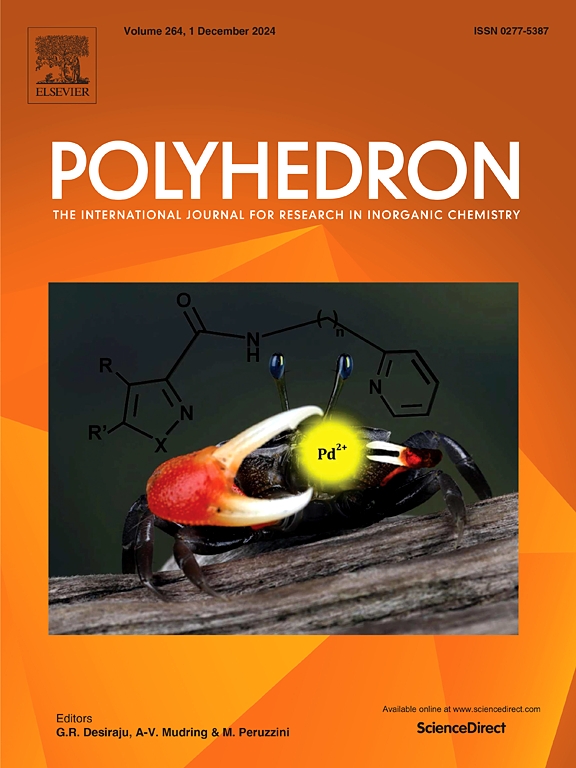CO release by redox stimuli and HSA interaction: Planning new CORMs based on µ-oxo triruthenium carbonyl clusters
IF 2.4
3区 化学
Q2 CHEMISTRY, INORGANIC & NUCLEAR
引用次数: 0
Abstract
Hydrogen peroxide promoted the release of carbon monoxide through the oxidation of the [Ru3O(CH3COO)6(L)2CO]0 complexes (L = pyridine (1a), dimethylpyrazine (2a) and 4-tert-butylpyridine (3a)). For 1a, a two-step reaction was observed in acetonitrile, with pseudo-first order rate constants kobs1 = (10.9 ± 2.9) × 10−3 s−1 and k2 = (11.8 ± 0.8) × 10−4 s−1, assigned to the oxidation reaction RuIII,III,II/RuIII,III,III followed by the substitution of the coordinated CO by a solvent molecule. In acetate buffer, only one-step was observable. Comparison of the reaction rate of three related clusters suggested a dependence of the rate constants with the basicity of the ligands. The 4-tert-butylpyridine ligand increases the oxidative-induced CO release, since σ-donation of electronic density by the more basic ligand facilitates the oxidation of the Ru(II) ion to Ru(III). We also addressed the possibility of interaction with a relevant biological target, using 1a as example. It is suggested that 1a interacts with human serum albumin (HSA) by the static mechanism, while the interaction of [Ru3O(CH3COO)6(pyridine)2H2O]+ (1b), the reaction product of 1a oxidation, also has a contribution from the dynamic mechanism. This implies that weak interactions play a major role, since the labile point does not seem to favour adduct formation by coordinative bonding.
氧化还原刺激和HSA相互作用的CO释放:基于微氧三钌羰基簇的新CORMs规划
过氧化氢通过氧化[ru30o (CH3COO)6(L)2CO]0配合物(L =吡啶(1a)、二甲基吡嗪(2a)和4-叔丁基吡啶(3a))促进一氧化碳的释放。对于1a,在乙腈中观察到一个两步反应,伪一级速率常数kobs1 =(10.9±2.9)× 10−3 s−1,k2 =(11.8±0.8)× 10−4 s−1,确定了氧化反应RuIII,III,II/RuIII,III,III,III,然后配位的CO被溶剂分子取代。在醋酸缓冲液中,只观察到一个台阶。三个相关簇的反应速率比较表明,速率常数与配体的碱度有关。4-叔丁基吡啶配体增加了氧化诱导的CO释放,因为碱性更强的配体给予电子密度σ,有利于Ru(II)离子氧化为Ru(III)。我们还讨论了与相关生物靶点相互作用的可能性,以1a为例。提示1a与人血清白蛋白(HSA)的相互作用是静态机制,而1a氧化反应产物[ru30o (CH3COO)6(吡啶)2H2O]+ (1b)的相互作用也有动态机制的贡献。这意味着弱相互作用起了主要作用,因为不稳定点似乎不利于通过配位键形成加合物。
本文章由计算机程序翻译,如有差异,请以英文原文为准。
求助全文
约1分钟内获得全文
求助全文
来源期刊

Polyhedron
化学-晶体学
CiteScore
4.90
自引率
7.70%
发文量
515
审稿时长
2 months
期刊介绍:
Polyhedron publishes original, fundamental, experimental and theoretical work of the highest quality in all the major areas of inorganic chemistry. This includes synthetic chemistry, coordination chemistry, organometallic chemistry, bioinorganic chemistry, and solid-state and materials chemistry.
Papers should be significant pieces of work, and all new compounds must be appropriately characterized. The inclusion of single-crystal X-ray structural data is strongly encouraged, but papers reporting only the X-ray structure determination of a single compound will usually not be considered. Papers on solid-state or materials chemistry will be expected to have a significant molecular chemistry component (such as the synthesis and characterization of the molecular precursors and/or a systematic study of the use of different precursors or reaction conditions) or demonstrate a cutting-edge application (for example inorganic materials for energy applications). Papers dealing only with stability constants are not considered.
 求助内容:
求助内容: 应助结果提醒方式:
应助结果提醒方式:


